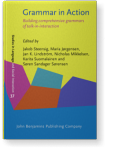Chapter 3
‘Idea-Suggestions’ in an interactional grammar
Sequential organization and grammatical formats
In this chapter, we explore the grammar of ‘Suggestions’
and the sequences they engender. ‘Suggestion’ is used here as a
technical term to refer to a speaker forwarding an action to be
performed by the recipient that will benefit the recipient. The data
suggest several sub-types of Suggestion, the focus here being on the
sub-type in which a speaker initiates a sequence by volunteering an
idea for something that the other might do to their benefit, which
we call ‘Idea-Suggestion’, or ‘I-Suggestion’. We discuss the formats
that speakers of American English use to put forth these kinds of
Suggestions, and argue that the tentativeness built into the work
that I-Suggestions do reveals what participants orient to in the
trajectory of the ensuing sequence. A final section explores how our
findings might be captured in an Interactional Grammar of American
English.
Article outline
- 1.Introduction
- 2.Data and procedure
- 3.Features of Idea-Suggestion sequences
- 3.1Preliminaries to I-Suggestions
- 3.2Formats for I-Suggestions
- 3.2.1‘Why don’t you’ (WDY) formats
- 3.2.2Formats with obligation and necessity modals
- 3.2.3Hypothetical conditional formats
- 3.2.4Formats with ability and possibility modals
- 3.2.5Formats with ‘you want to’
- 3.3Responses to I-Suggestions
- 4.Idea-Suggestions vs. Advice-Suggestions
- 5.Idea-Suggestions in an interactional grammar
- 5.1Idea-Suggestions: From action to grammar
- 5.2Idea-Suggestions: From grammar to action
- 6.Discussion
- 7.Conclusion
-
Notes
-
References
This content is being prepared for publication; it may be subject to changes.
